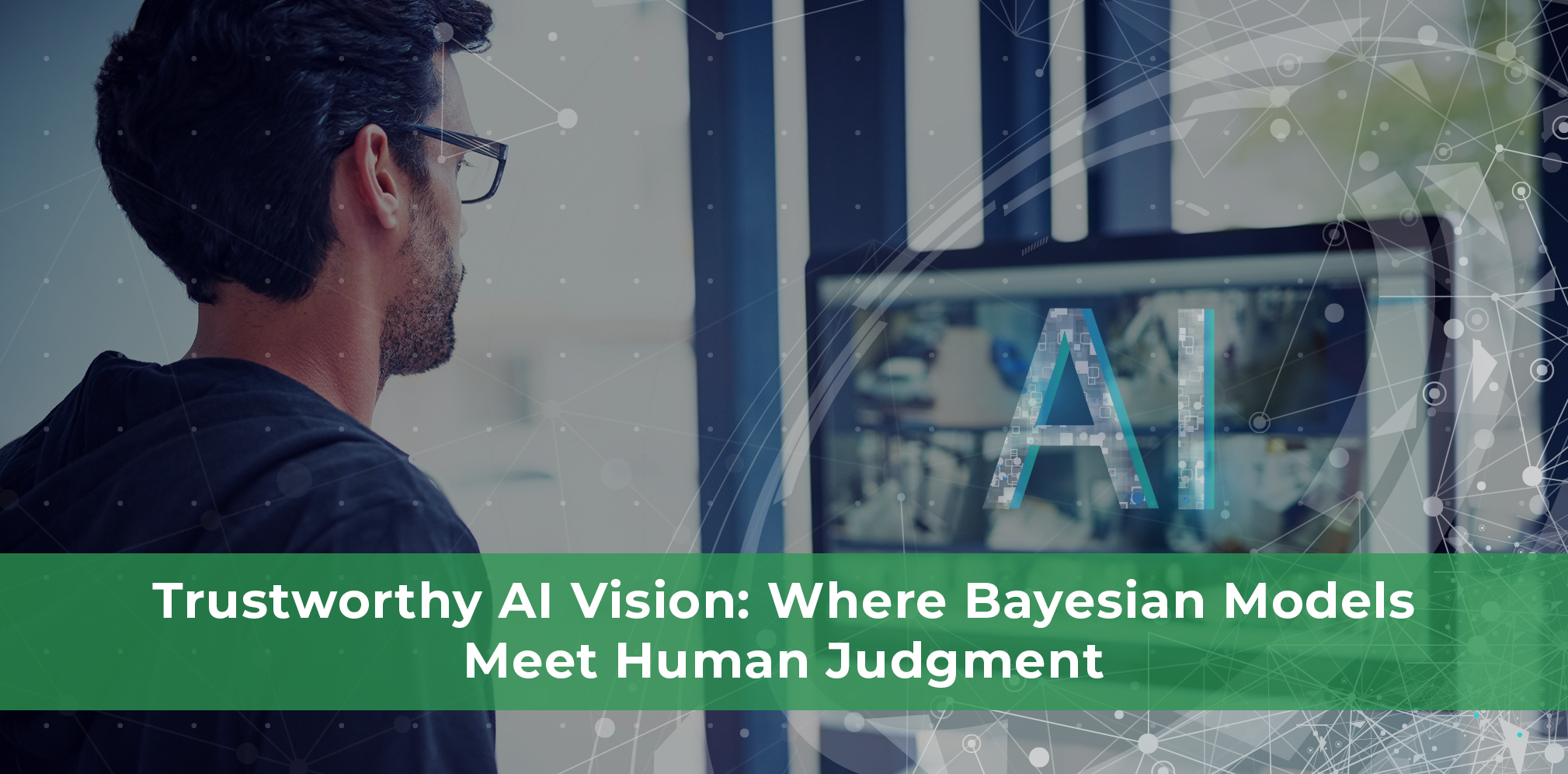As AI systems advance toward fully autonomous vehicles, smart cities, industrial robotics, and defence. Computer Vision is no longer just about classification accuracy. It’s about making decisions under uncertainty, managing risk, and building trust. This is where Bayesian methods are gaining momentum. Offering probabilistic reasoning that lets models say not just what they see, but how sure they are.
But here’s the challenge: Bayesian AI is only as good as the data it learns from, and the feedback it receives under ambiguity.
This is where Human-in-the-Loop (HITL) annotation becomes not just relevant, but indispensable. At NextWealth, we believe the future of intelligent vision systems lies at the intersection of Bayesian modelling and human judgment; a convergence that we’re actively building every day.
Why Bayesian Computer Vision Needs Human Judgment
Traditional CV models output deterministic predictions. A standard system might say: “There is a pedestrian.” A Bayesian model, in contrast, says: “There’s an 85% probability of a pedestrian here, with 70% confidence in its bounding box.”
This probabilistic approach brings immense value to AI:
- It helps models reason under real-world ambiguity.
- It enables risk-aware decisions – critical in autonomous driving or medical imaging.
- It provides confidence intervals that improve explainability.
- Most importantly, it allows systems to ask for human oversight in ambiguous scenarios.
But there’s a paradox: to model uncertainty, models need uncertainty-aware data. Poorly annotated data leads to misleading confidence. Edge cases become failure points. That’s where our HITL framework steps in; not just as a quality layer, but as a strategic enabler of probabilistic learning.
HITL: The Human Bridge in Bayesian Pipelines
Bayesian pipelines thrive on recursive inference. Posterior beliefs feed future priors. At three critical stages, HITL annotation becomes foundational:
1. Building Reliable Ground Truth from Real-World Ambiguity
In segmentation, detection, or object tracking, the nuance between a clearly visible car and a foggy outline matters deeply.
Our HITL annotators at NextWealth are trained to:
- Label ambiguous objects with graded certainty (e.g., “likely bicycle” vs. “clear bicycle”).
- Create confidence-weighted masks for semantic or instance segmentation.
- Follow escalation rubrics for edge cases, ensuring judgment is standardized.
This ensures that models learn how certain to be & not just what to detect.
2. Closing the Loop with Model-Guided Feedback
Bayesian models often flag low-confidence predictions. Instead of discarding them, our workflows activate HITL review:
- Annotators recheck flagged frames, correct where needed, and inject clarity.
- Data pipelines get richer, with human-validated feedback loops.
- We train models to defer to humans in critical or ambiguous zones—like school areas or construction sites in AV maps.
We integrate this HITL layer across platforms like Taskmonk, QGIS, Dataloop, etc.—turning static annotation into an interactive, uncertainty-aware process.
3. Interpreting Probabilistic Outputs in Real-World Context
Uncertainty doesn’t stop at the input layer. In downstream systems—like AV planning or robotic motion prediction—Bayesian models output:
- Probabilistic trajectories
- 3D spatial distributions (e.g., LiDAR + camera fusion)
- Semantic heatmaps
Our SMEs don’t just check correctness. They analyse:
- Whether model uncertainty aligns with real-world ambiguity
- Where models are overconfident (dangerous) or underconfident (inefficient)
- Inconsistencies across time; flagging erratic confidence behaviours
This process helps align AI reasoning with human judgment, not just math.
How NextWealth Trains Annotators for Probabilistic Vision Systems
At NextWealth, we don’t just build annotation teams, we cultivate domain-aware reasoning partners for AI. As the industry shifts toward probabilistic vision systems, our training programs evolve to meet the demand for uncertainty-aware, context-rich labelling.
Key Training Principles We Follow:
➤Uncertainty Literacy: Annotators are introduced to core Bayesian concepts like confidence intervals, prediction thresholds, and ambiguity tagging. We train them to distinguish between visual ambiguity (e.g., fog, occlusion) and semantic uncertainty (e.g., unclear object class), enabling better ground truth for AI models that reason probabilistically.
➤Rubric-Driven Decision Trees: We use structured annotation rubrics that go beyond binary decisions. For example, annotators can tag an object as “likely pedestrian”, “ambiguous class”, or “needs escalation”—ensuring that graded certainty levels are reflected in the dataset.
➤Platform Simulations & Feedback Loops: Before going live on real-world tasks, trainees undergo scenario-based simulations where they handle edge cases flagged by model predictions. SMEs provide real-time feedback, creating a loop where human intuition learns from machine uncertainty and vice versa
➤Domain Immersion: Whether it’s automotive, medical, or geospatial AI, each team is immersed in the domain’s risk and safety nuances. For instance, an AV annotator must understand why an overconfident prediction near a school zone can be dangerous, shaping how they approach borderline annotations.
By combining structured rubric design, scenario training, and domain immersion, NextWealth ensures that our HITL teams are not just accurate—but aligned with how probabilistic AI thinks, learns, and improves.
Real-World Results from Our Clients and Projects
➤Autonomous Driving (ADAS/AV)
For a leading global client, we delivered:
- Semantic segmentation with confidence grading across 5 road classes
- HITL overlays for rain/fog/night driving zones
- Verified 98.7% precision/recall through a multi-layer QA loop
These annotations were used in Bayesian path-planning modules to predict lane shifts under risk.
➤HD Maps Enhanced by Human-Augmented Sensor Fusion
In LiDAR-camera fused mapping:
- Our annotators flagged low-certainty zones in panoramic 360° imagery
- Human insight corrected overlapping or occluded road signs, curbs, and poles
- Bayesian SLAM engines used this to adjust map updates and reduce false positives in areas of GPS drift
➤Pedestrian Intention & Trajectory Prediction
Working on pedestrian trajectory forecasting:
- We tagged intention cues like “likely to cross” or “looking away”
- Model predictions were cross-validated with real-world trajectories
- HITL retraining helped improve performance in dynamic, crowded intersections
Pedestrian Intention & Trajectory Prediction
We’re entering a new era where vision systems must justify their predictions, not just make them. Whether in autonomous vehicles, radiology scans, or surveillance AI, regulators and users alike demand models that can:
- Operate safely under uncertainty
- Flag edge cases for human attention
- Provide interpretable outputs; not just classifications
Bayesian CV makes this possible. But only if its foundation the data is trustworthy and nuanced.
At NextWealth, our 5,000+ skilled annotators, SME-led QA teams, and domain-first training processes are already building this foundation. We don’t just label data—we help AI understand when not to trust itself, and when to ask a human.
Looking Ahead: Scaling Probabilistic Vision with Human Insight
We’re already investing in:
- Active Learning Pipelines where models “ask” for human review in low-confidence cases
- Uncertainty-aware Dataset Curation for leaner, smarter training sets
- Prediction Calibration Dashboards for AV and robotics clients to monitor model behaviour and trust scores
- Bias and Overconfidence Modelling, using HITL annotations as human-aligned guardrails
Our vision is to build systems of trust, where AI and humans co-evolve. We believe that in the coming years, HITL teams like ours will become embedded partners in:
- Continuous model QA
- Risk calibration
- Regulatory audit trails
- AI alignment and safety assurance
Final Take: Building the Future of Vision—One Judgement at a Time
The future of Computer Vision is not purely automated. It’s probabilistic. It’s explainable. It’s human-aware.
As Bayesian AI gains ground, Human-in-the-Loop becomes the missing link not just to make models better, but to make them aligned with how humans actually see and reason.
At NextWealth, we’re not just labelling pixels, we’re shaping the next generation of safe, adaptive, and trustworthy vision systems. One frame, one edge case, one human insight at a time.
Key Takeaways….
- Bayesian Computer Vision brings uncertainty-aware intelligence to AI systems—but it relies heavily on nuanced, trustworthy training data.
- Human-in-the-Loop (HITL) annotation enables AI to recognize ambiguity, defer in critical cases, and align its confidence with real-world conditions.
- NextWealth’s HITL model is not just a QA layer; it is a feedback-rich, context-driven system that fuels smarter AI through continuous human insight.
- Our annotators are trained in Bayesian reasoning, ambiguity detection, and graded certainty labelling equipping them to support AI in high-risk domains like AV, robotics, and geospatial mapping.
- Real-world deployments show that HITL improves performance in ADAS path planning, LiDAR-based SLAM systems, and pedestrian motion prediction—with precision scores up to 98.7%.
- Looking ahead, NextWealth is scaling support for probabilistic AI through:
-Active learning pipelines
-Uncertainty-aware dataset curation
-Prediction calibration dashboards
-Bias detection frameworks
Ultimately, we believe trust in AI starts with the human loop—and our mission is to build vision systems that are not just intelligent, but responsible and safe

